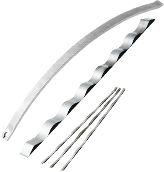Question zak 2008/10/4(Sat) 14:42
My apologies for asking such an easy question.
Question 1. Do “Allowable bending stress” and “yield strength” have the same meaning?
Question 2: Do “yield strength” and “yield strength” have the same meaning? Thank you for your response.
Answer Tokai Spring 2008/10/5(Sun) 16:42
Thank you for your question, Zak!
“Allowable bending stress” and “yield strength” do not have the same meaning.
The allowable bending stress is the allowable stress of the leaf spring, while the yield strength is the stress that causes plastic strain of the material.
In question ②, “proof stress” and “proof strength” are the same words.
Thank you!
Answer Anonymous 2017/11/20(Mon) 11:36
I have been using this page for reference for quite a while.
Thank you for all the useful information. I have a few questions for you.
① Is it possible to think that the allowable bending stress that causes the plastic strain of the material to occur in the above question is 70% of the allowable stress for the leaf spring? Is it okay to think of it as a value?
② In the leaf spring calculation formula page, is 3B in the 1-2 trapezoidal cantilever thin leaf spring calculation formula 3EI? b1 is written, b is not, but is it the width of the bottom of the trapezoid?
③ Is there a Goodman diagram for leaf springs?
I’m sorry for asking many questions, thank you in advance.
Answer Tokai Spring 2017/11/20(Mon) 13:12
Spring Newbie, thank you for always trusting our forum!
I hope we will have a chance to work together in the future!
Here are the answers to your questions.
① Most leaf springs are evaluated by bending stress, but in general, I think that the use of the spring should not exceed 80% of the tensile strength of the material.
Depending on the shape and the method of use, there are cases in which the safety is guaranteed even when the tensile strength exceeds 80%.
② There was not enough explanation on the homepage, so I will add information as soon as possible!
B in 3B is as shown here: B=bh^3E/12 in which b=plate width, h=plate thickness.
When the plate thickness is thin, B=bh^3E/12(1-ν^2) in which E=modulus of elasticity, ν=Poisson’s ratio (plate thickness of up to about 0.3mm is standard)
③ Please go to this link of JIS B2709 about bending stress for your reference bending stress Allowable tensile stress reference material
Anonymousさま
いつも相談室をご愛用頂きましてありがとうございます!
今後もよろしくお願いします!
ご質問のご回答ですが、以下の通りです。
①板バネは曲げ応力で評価する場合がほとんどですが、一般的には、材料の引張強さの80%を
目安として差支えないかと思います。形状や使用方法によっては、80%より安全を見る場合も
あります。
②ホームページで説明が不足していましたので、早急に情報追加しておきます!
3BのBは右記の通りです。B=bh^3E/12
b=板幅、h=板厚を意味します。
また、板厚が薄い場合は、B=bh^3E/12(1-ν^2)
E=縦弾性係数、ν=ポワソン比
(板厚0.3mm程度までを目安します)
③JIS B2709に曲げ応力の参考資料がございます。ご参考ください。
許容引張応力参考資料
Answer Ayman 2022/11/20(Sun) 0:46
I want to know the exact material tensile strength and yield of stainless steel 302 compression spring with 0.575″ wire diameter?
Answer Tokai Spring 2022/11/22(Tue) 10:48
Thank you for your inquiry.
Regarding stainless steel 302 for compression springs
We are sorry, we do not handle this kind of material, so we cannot answer your question.
If you have any other questions, please let me know anytime!
Best Regards
Tokai Spring’s support team
We are happy to answer any inquiries regarding technology, specifications, materials, etc. Please feel free to ask.

















